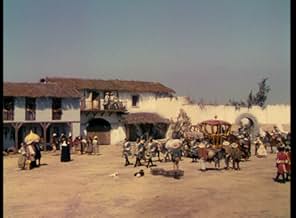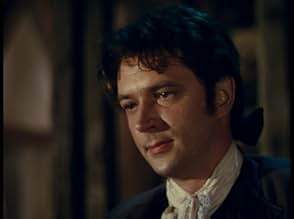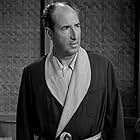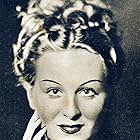IMDb RATING
7.0/10
3.5K
YOUR RATING
Three men of varying social standing - a viceroy, a bullfighter, and a soldier - vie for the affections of an actress in 18th-century Peru.Three men of varying social standing - a viceroy, a bullfighter, and a soldier - vie for the affections of an actress in 18th-century Peru.Three men of varying social standing - a viceroy, a bullfighter, and a soldier - vie for the affections of an actress in 18th-century Peru.
- Awards
- 1 win
William Tubbs
- Aubergiste
- (as William C. Tubbs)
Renato Chiantoni
- Capitaine Fracasse
- (uncredited)
Fedo Keeling
- Vicomte
- (uncredited)
Edward Febo Kelleng
- Viscount
- (uncredited)
Alfredo Kolner
- Florindo
- (uncredited)
Storyline
Did you know
- TriviaFrançois Truffaut admired this film so much, he named his own production company (Les Films Du Carrosse) after it. He also reportedly referred to The Golden Coach (1952) as "the noblest and most refined film ever made."
- Quotes
Aubergiste: How do you like the New World?
Don Antonio: It will be nice when it's finished.
- ConnectionsFeatured in Histoire(s) du cinéma: Toutes les histoires (1989)
Featured review
... or La Carrozza d'Oro, or Le Carrosse d'Or. Take your pick: the film has an early flavour of the "Euro-pudding", with a mixed (and sometimes mixed-up) Anglo-Italian cast. It was shot principally in English, which meant an extra layer of strain for La Magnani, whose manic, over-the-top performance can't quite hide the somewhat anaemic storyline.
Luckily, her overacting fits well enough with the character's context and the decidedly light and bawdy mood of the whole piece: she's a professional Commedia del Arte 'actor' touring a 16th Century Latin America which decadent Spaniards hold in their venal grip. The great Italian star drags behind her a motley crew of fellow-Italians who match her quiver for quiver in the wild hand-gesturing repertoire and performs convincingly the stage stunts that were the Commedia's stock in trade. Magnani's antics also serve as a welcome distraction from leading man Paul Campbell's comatose acting. This American non-entity gives "wooden" a bad name. Whilst La Magnani keeps running through her vast back-catalogue of facial expressions, he only ever seems able to muster two, at best. Was Renoir asleep when this guy auditioned?
Anyway, none of that matters, because this is a film that is as much art-directed as it is directed. Huge respect is owed to designers Mario Chiari and Gianni Poldori for sets that manage to be both lavishly theatrical and convincingly lived in. Maria de Matteïs and Ginevra Pasolini match their male colleagues' panache and inventiveness with a dazzling range of costumes that combine with the lush colour palette of the sets to deliver an exquisitely sensuous fantasia of this distant time and place. Rarely was the glorious three-strip Technicolor process used with such erotic abandon and sheer vitality.
Thank God for this too, because it's not as if the lame script, with its flat-footed storyline and schematic comedy was anything to write home about. There is no doubting Renoir's genuine desire to pay tribute to the Commedia genre, and his loving attention to the detail of early theatrical craft draws you in. After all, wasn't this popular form of street theatre an early precursor to the great art perfected later on the big screen by the likes of Lubitsch or Renoir himself?
In the end, I feel an indulgent love for this film, a late entry into the great French master's career and -like French Cancan - a little bit 'so what?'. Not only could I get drowned again and again in its sensuous celebration of Technicolor as life and drama, but there is also a core quality that has to do with how Renoir renders the spiritual essence of the Commedia company: throughout the film, these displaced paupers and underfed globe-trotters display total servitude and total freedom in equal measure. These are the two opposites of their fraught but impassioned lives and the source of the manic energy they need for the performance that will buy them the day's only meal. As a filmmaker who frequently struggled to achieve his vision against the strictures of the commercial film industry, Renoir seems to know intimately what those characters' lives were about.
Luckily, her overacting fits well enough with the character's context and the decidedly light and bawdy mood of the whole piece: she's a professional Commedia del Arte 'actor' touring a 16th Century Latin America which decadent Spaniards hold in their venal grip. The great Italian star drags behind her a motley crew of fellow-Italians who match her quiver for quiver in the wild hand-gesturing repertoire and performs convincingly the stage stunts that were the Commedia's stock in trade. Magnani's antics also serve as a welcome distraction from leading man Paul Campbell's comatose acting. This American non-entity gives "wooden" a bad name. Whilst La Magnani keeps running through her vast back-catalogue of facial expressions, he only ever seems able to muster two, at best. Was Renoir asleep when this guy auditioned?
Anyway, none of that matters, because this is a film that is as much art-directed as it is directed. Huge respect is owed to designers Mario Chiari and Gianni Poldori for sets that manage to be both lavishly theatrical and convincingly lived in. Maria de Matteïs and Ginevra Pasolini match their male colleagues' panache and inventiveness with a dazzling range of costumes that combine with the lush colour palette of the sets to deliver an exquisitely sensuous fantasia of this distant time and place. Rarely was the glorious three-strip Technicolor process used with such erotic abandon and sheer vitality.
Thank God for this too, because it's not as if the lame script, with its flat-footed storyline and schematic comedy was anything to write home about. There is no doubting Renoir's genuine desire to pay tribute to the Commedia genre, and his loving attention to the detail of early theatrical craft draws you in. After all, wasn't this popular form of street theatre an early precursor to the great art perfected later on the big screen by the likes of Lubitsch or Renoir himself?
In the end, I feel an indulgent love for this film, a late entry into the great French master's career and -like French Cancan - a little bit 'so what?'. Not only could I get drowned again and again in its sensuous celebration of Technicolor as life and drama, but there is also a core quality that has to do with how Renoir renders the spiritual essence of the Commedia company: throughout the film, these displaced paupers and underfed globe-trotters display total servitude and total freedom in equal measure. These are the two opposites of their fraught but impassioned lives and the source of the manic energy they need for the performance that will buy them the day's only meal. As a filmmaker who frequently struggled to achieve his vision against the strictures of the commercial film industry, Renoir seems to know intimately what those characters' lives were about.
- How long is The Golden Coach?Powered by Alexa
Details
Box office
- Gross worldwide
- $439
- Runtime1 hour 43 minutes
- Color
- Aspect ratio
- 1.37 : 1
Contribute to this page
Suggest an edit or add missing content















